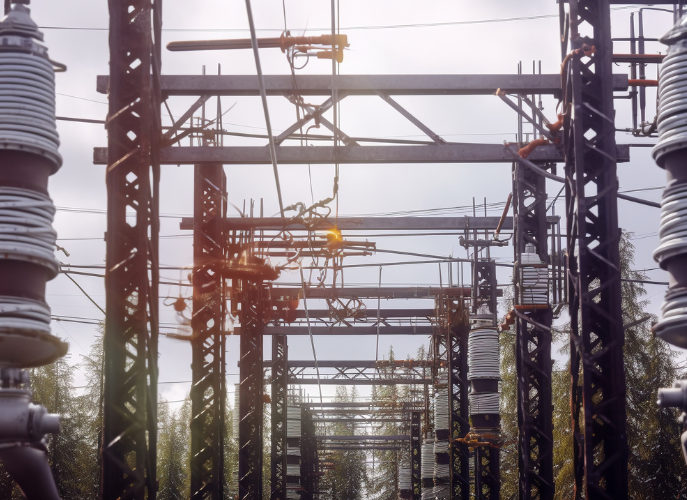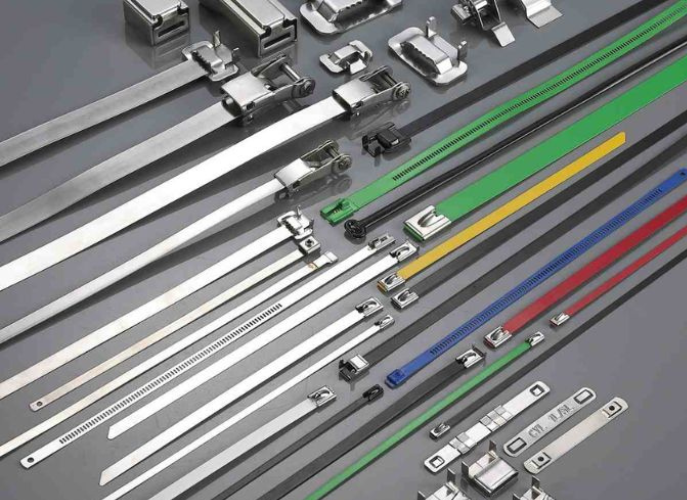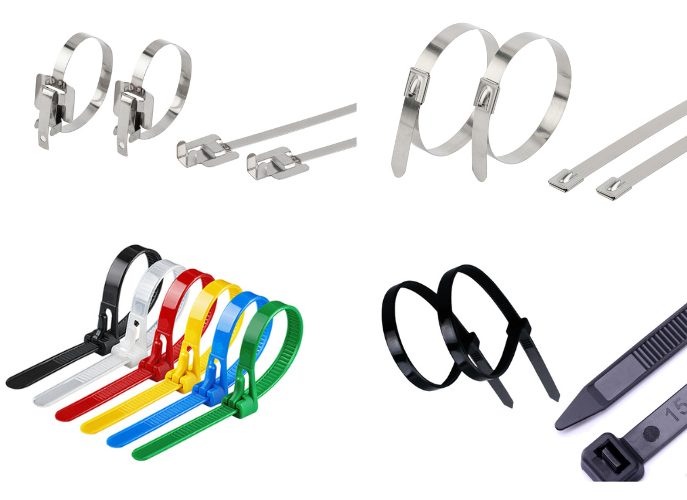
- Supports
How Much Heat Can Cable Ties Handle?
Cable ties, often called zip ties, are versatile fasteners widely used in various industries for bundling and securing cables, wires, and other objects. While cable ties are simple in design, their ability to withstand different environmental conditions, particularly heat, can vary significantly depending on the material they are made from. This blog will delve into how much heat cable ties can handle, with a specific focus on Heat Resistant Cable Ties and Heat Stabilized Cable Ties. Understanding the thermal limits of these essential tools is crucial for ensuring their effectiveness and safety in high-temperature applications.
What are Cable Ties?
Cable ties are made from various materials, each with distinct properties that determine their suitability for different environments. The most common material used in cable ties is nylon, particularly Nylon 6/6, known for its strength, flexibility, and resistance to chemicals and UV light. However, not all cable ties are created equal when it comes to heat resistance. The ability of a cable tie to withstand high temperatures is vital in applications such as automotive, aerospace, and industrial manufacturing, where exposure to heat is frequent. This blog will focus on Heat Resistant Cable Ties and Heat Stabilized Cable Ties of heat-resistant cable strips.
Types of Cable Ties Based on Heat Resistance
When considering how much heat a cable tie can handle, it's essential to distinguish between standard cable ties, heat-resistant cable ties, and heat-stabilized cable ties. Each type is designed to perform under different temperature ranges.
1. Standard Nylon Cable Ties
Standard nylon cable ties, typically made from Nylon 6/6, are suitable for general-purpose applications. These ties can withstand temperatures up to around 185°F (85°C). While they perform well under normal conditions, their heat resistance is limited, making them unsuitable for high-temperature environments.
2. Heat Resistant Cable Ties
Heat Resistant Cable Ties are specially designed to endure higher temperatures than standard ties. These ties are often made from materials such as Nylon 6/6 with added heat stabilizers or entirely different polymers like Polyetheretherketone (PEEK) or Fluoropolymers. Heat-resistant cable ties can typically withstand temperatures up to 250°F (121°C) or higher, depending on the specific material used.
3. Heat Stabilized Cable Ties
Heat Stabilized Cable Ties are a subset of heat-resistant ties, specifically designed for prolonged exposure to elevated temperatures. These ties are typically made from Nylon 6/6 with special additives that enhance their heat stability. They can withstand continuous exposure to temperatures up to 221°F (105°C) and short-term exposure to even higher temperatures. Heat-stabilized cable ties are commonly used in environments where sustained high temperatures are the norm, such as in automotive engines or industrial machinery.
What is Heat Resistance in Cable Ties
The heat resistance of a cable tie is determined by several factors, including the material's thermal stability, the presence of heat stabilizers, and the tie's design. Let's explore these factors in more detail.
1. Material Composition
The material from which a cable tie is made is the primary determinant of its heat resistance. Nylon 6/6, the most common material, has good overall properties but its heat resistance can be limited. Other materials, like PEEK or Fluoropolymers, offer superior heat resistance and are used in specialized applications where extreme temperatures are expected.
For example, PEEK cable ties can withstand continuous temperatures up to 500°F (260°C), making them suitable for extreme environments such as aerospace and high-temperature industrial processes.
2. Heat Stabilizers
Heat stabilizers are additives mixed with the base material during the manufacturing process to enhance the material's ability to withstand high temperatures. In heat-stabilized cable ties, these stabilizers prevent the nylon from degrading at elevated temperatures, thus extending the tie's service life in hot environments.
Heat stabilizers work by inhibiting the thermal oxidation of the polymer, which is the main cause of degradation at high temperatures. This means that heat-stabilized cable ties can maintain their mechanical properties, such as tensile strength and flexibility, even when exposed to heat over long periods.
3. Design and Structure
The design and structure of a cable tie also play a role in its heat resistance. Thicker ties or those with reinforced locking mechanisms may be better suited to withstand the stresses of high temperatures. The shape and surface area of the tie can affect how heat is dissipated, potentially influencing its overall performance in a hot environment.
Applications of Heat Resistant Cable Ties
Heat-resistant and heat-stabilized cable ties are used in various industries where high temperatures are a concern. Here are some common applications:
1. Automotive Industry
In the automotive industry, cable ties are used to secure wiring harnesses, fuel lines, and other components within the engine compartment, where temperatures can soar. Heat-resistant cable ties are crucial here, as standard ties could fail under the intense heat generated by the engine and exhaust systems. For example, heat-stabilized cable ties might be used to secure cables near the engine block, where temperatures can reach up to 221°F (105°C) or more.
2. Aerospace Industry
In aerospace applications, the materials used must withstand extreme conditions, including high temperatures. Heat-resistant cable ties made from materials like PEEK are often employed to secure wiring and components in aircraft engines and other high-temperature areas. These ties ensure that critical systems remain securely fastened, even in the most demanding environments.
3. Industrial Manufacturing
In industrial manufacturing, particularly in processes involving high-temperature machinery or environments, heat-resistant cable ties are essential. These ties are used to bundle and secure cables, hoses, and other components in areas where temperatures may exceed the limits of standard nylon ties. For instance, in a steel mill, where ambient temperatures can be very high, heat-stabilized cable ties ensure that electrical and pneumatic lines remain securely fastened.
4. Electrical Installations
In electrical installations, especially those exposed to high temperatures such as in power plants or near furnaces, heat-resistant cable ties are used to ensure that wires remain securely bundled. These ties prevent the wires from sagging or becoming loose due to thermal expansion or degradation, which could lead to electrical faults or hazards.
5. Marine and Offshore Applications
In marine and offshore environments, cable ties are exposed to both high temperatures and corrosive elements like saltwater. Heat-resistant and UV-resistant cable ties are often used in these settings to ensure durability and reliability. These ties are crucial for securing electrical cables and other components on ships, oil rigs, and other marine structures.

Comparing Heat Resistant and Heat Stabilized Cable Ties
While both heat-resistant and heat-stabilized cable ties are designed to perform in high-temperature environments, there are some key differences between the two.
1. Temperature Range
Heat-resistant cable ties generally have a higher temperature tolerance than heat-stabilized ties. For example, while heat-stabilized ties can withstand continuous temperatures up to 221°F (105°C), heat-resistant ties made from materials like PEEK can handle up to 500°F (260°C). This makes heat-resistant ties suitable for more extreme environments.
2. Long-Term Exposure
Heat-stabilized cable ties are specifically designed for long-term exposure to moderately high temperatures. They maintain their mechanical properties over extended periods, making them ideal for applications where the ties will be exposed to consistent heat. In contrast, heat-resistant ties are better suited for environments where extreme temperatures are present, even if only intermittently.
3. Material Composition
The material composition of heat-resistant and heat-stabilized ties often differs. Heat-stabilized ties are typically made from nylon with added stabilizers, while heat-resistant ties might be made from more specialized materials like PEEK or Fluoropolymers. These different materials provide varying levels of heat resistance, chemical resistance, and mechanical strength.
4. Cost Considerations
Due to their advanced material composition and superior heat resistance, heat-resistant cable ties are generally more expensive than heat-stabilized ties. When choosing between the two, it’s important to consider the specific temperature requirements of your application, as well as budget constraints.
How to Choose the Right Heat Resistant Cable Ties
Selecting the appropriate heat-resistant cable tie for your application involves considering several factors, including the expected temperature range, environmental conditions, and the specific requirements of your project. Here are some tips to help you make the right choice:
1. Determine the Maximum Operating Temperature
The first step in choosing the right cable tie is to determine the maximum temperature the ties will be exposed to. This will help you decide whether a heat-resistant or heat-stabilized cable tie is necessary. If the temperature exceeds 221°F (105°C), you’ll likely need a heat-resistant tie made from a material like PEEK.
2. Consider the Duration of Exposure
Consider how long the cable ties will be exposed to high temperatures. If the exposure is continuous or long-term, heat-stabilized cable ties may be sufficient. However, for extreme or intermittent high temperatures, a more robust heat-resistant tie is recommended.
3. Evaluate the Environment
Assess the environment where the cable ties will be used. Factors such as UV exposure, humidity, chemical exposure, and mechanical stress can all affect the performance of the cable ties. Choose a tie that can withstand not only the heat but also the other environmental conditions present.
4. Check Material Compatibility
Ensure that the material of the cable tie is compatible with the components it will be securing. For example, in applications involving exposure to harsh chemicals, a PEEK cable tie may be more appropriate than a standard nylon tie due to its superior chemical resistance.
5. Budget Considerations
While heat-resistant cable ties are generally more expensive, they offer greater durability and performance in high-temperature environments. Weigh the cost against the potential risks of using a less expensive, lower-performance tie. In critical applications, the investment in a higher-quality tie is often justified.
Proper Installation of Heat Resistant Cable Ties
Even the best heat-resistant cable ties can fail if they are not installed correctly. Here are some best practices for ensuring proper installation:
1. Use the Right Tool
Using a cable tie installation tool designed for the specific type of tie you are using is crucial. These tools ensure that the tie is tightened to the correct tension without over-tightening, which could damage the tie or the cables it is securing.
2. Avoid Over-Tightening
Over-tightening a cable tie can cause it to crack or weaken, reducing its heat resistance and overall effectiveness. Ensure that the tie is snug but not excessively tight. Proper tension will secure the cables without putting undue stress on the tie.
3. Trim Excess Tie Length
After securing the tie, trim any excess length close to the locking mechanism. Leaving excess material can create a point of weakness where the tie could break under heat or stress. Using a flush-cut tool can help achieve a clean cut that minimizes the risk of injury or damage.
4. Regular Inspection
In high-temperature environments, it’s essential to regularly inspect cable ties for signs of wear, cracking, or degradation. Replace any ties that show signs of damage to prevent potential failures. Regular maintenance is key to ensuring the longevity and reliability of your cable ties.
Conclusion
Heat-resistant and heat-stabilized cable ties are essential tools in environments where high temperatures are a concern. Understanding the thermal limits of these ties and selecting the right type for your application is crucial for ensuring safety and reliability. Whether in automotive, aerospace, industrial manufacturing, or electrical installations, the right cable tie can make all the difference in maintaining secure and durable connections.
By considering factors such as material composition, environmental conditions, and installation practices, you can choose the best heat-resistant cable ties for your needs. As technology continues to advance, the range and capabilities of these essential fasteners will only improve, offering even greater performance and reliability in the most challenging conditions.
Related Cable Accessories
LATEST NEWS
Inquire About Cable Accessories
Address:
NO.17 Liangwang Shan Road, Lianghu Industry, Lianghu Street, Shangyu Area, Shaoxing City, Zhejiang Province, China








